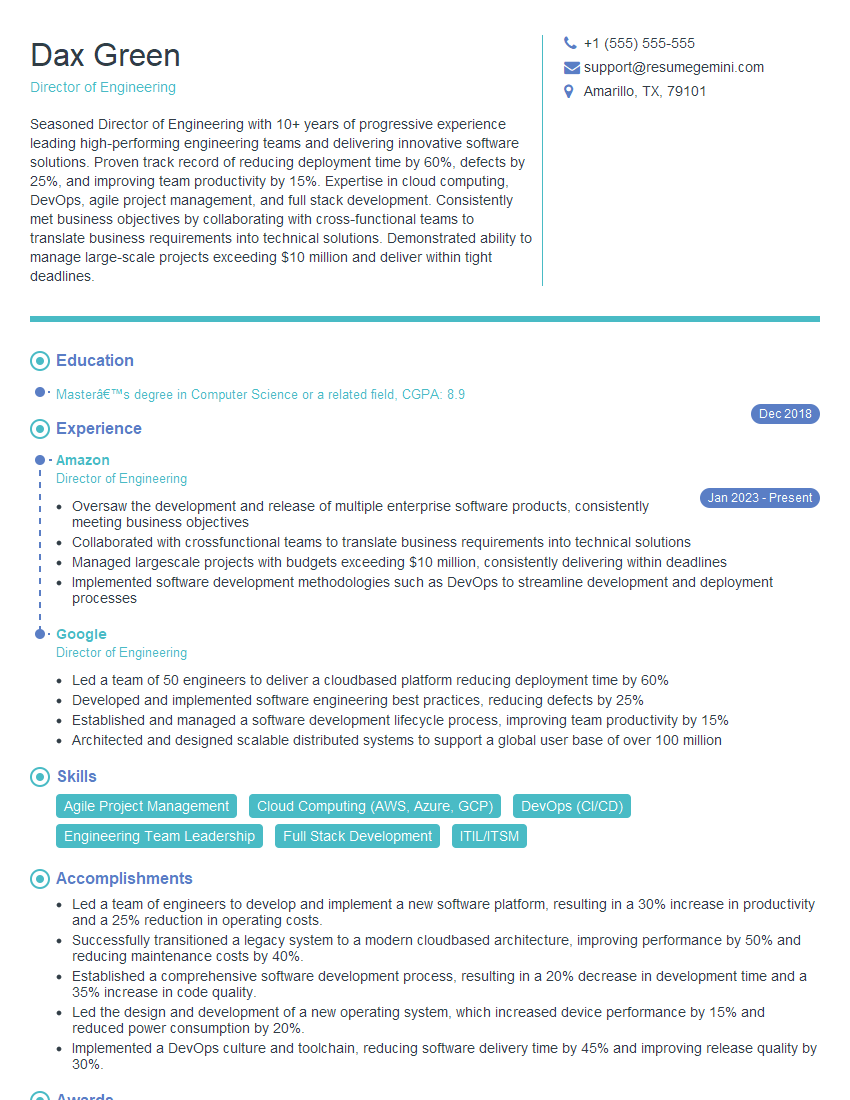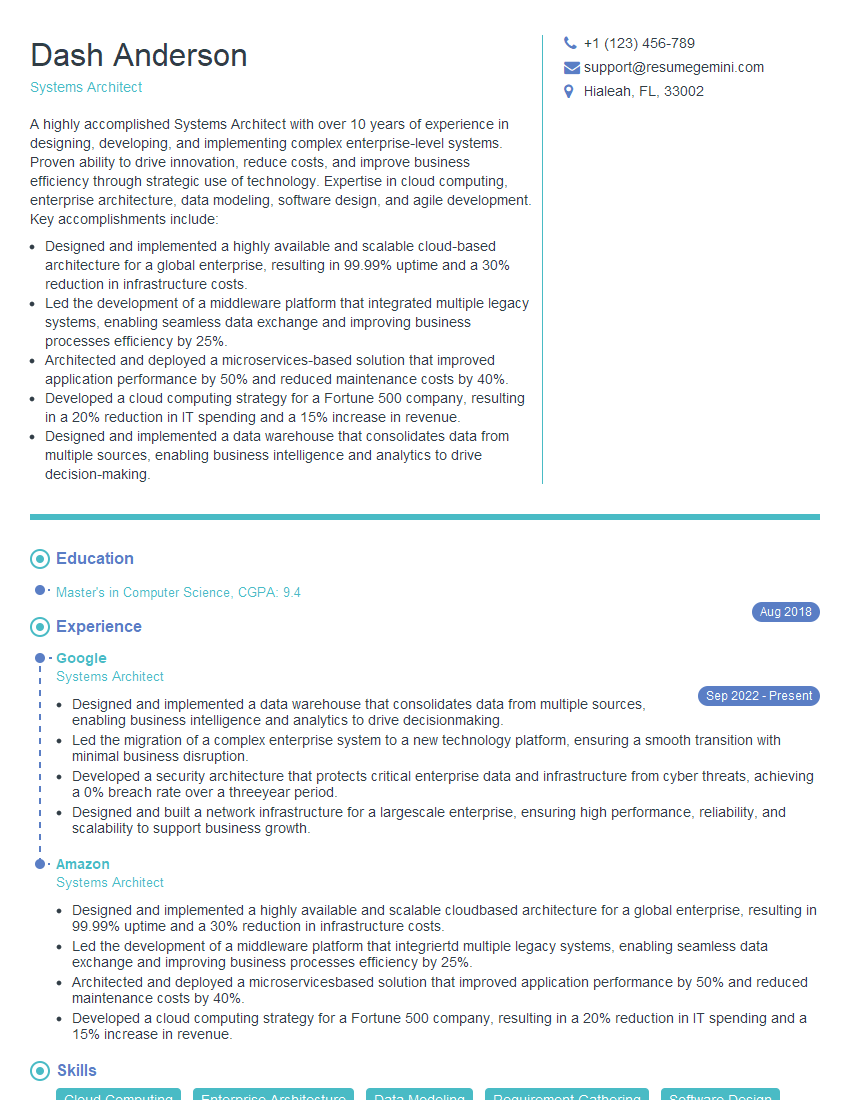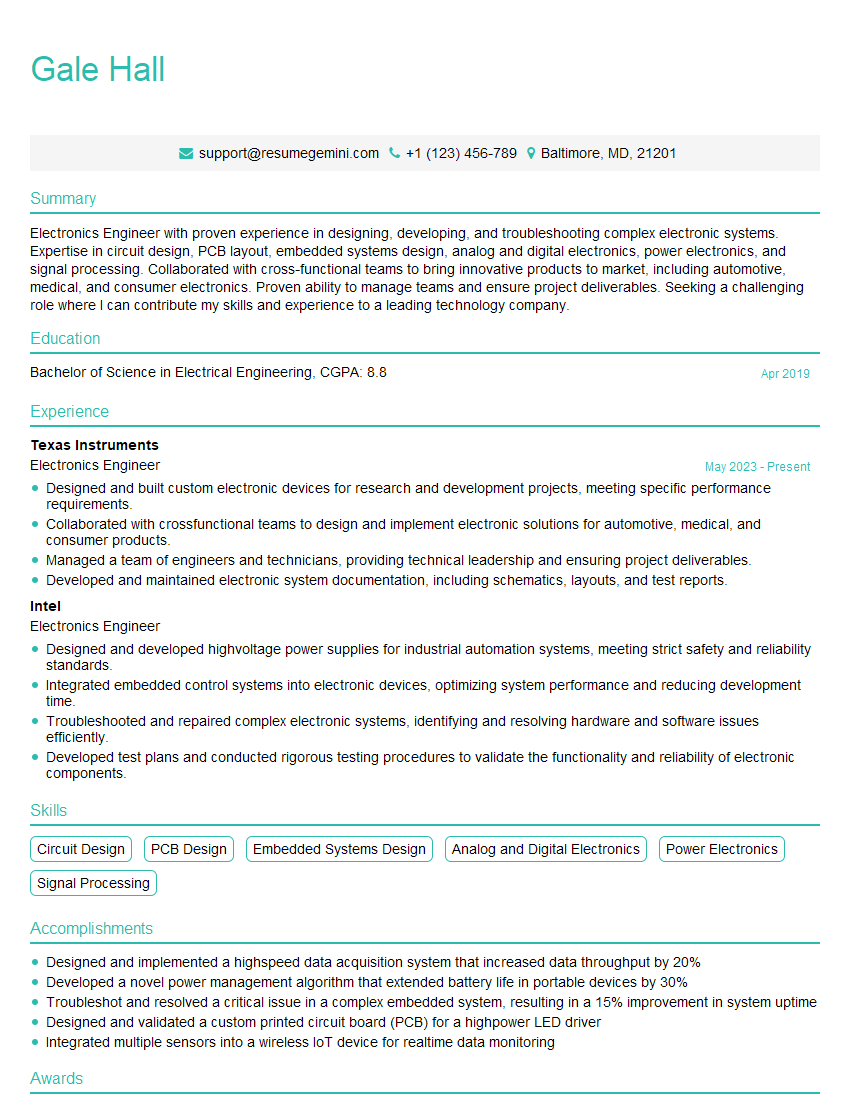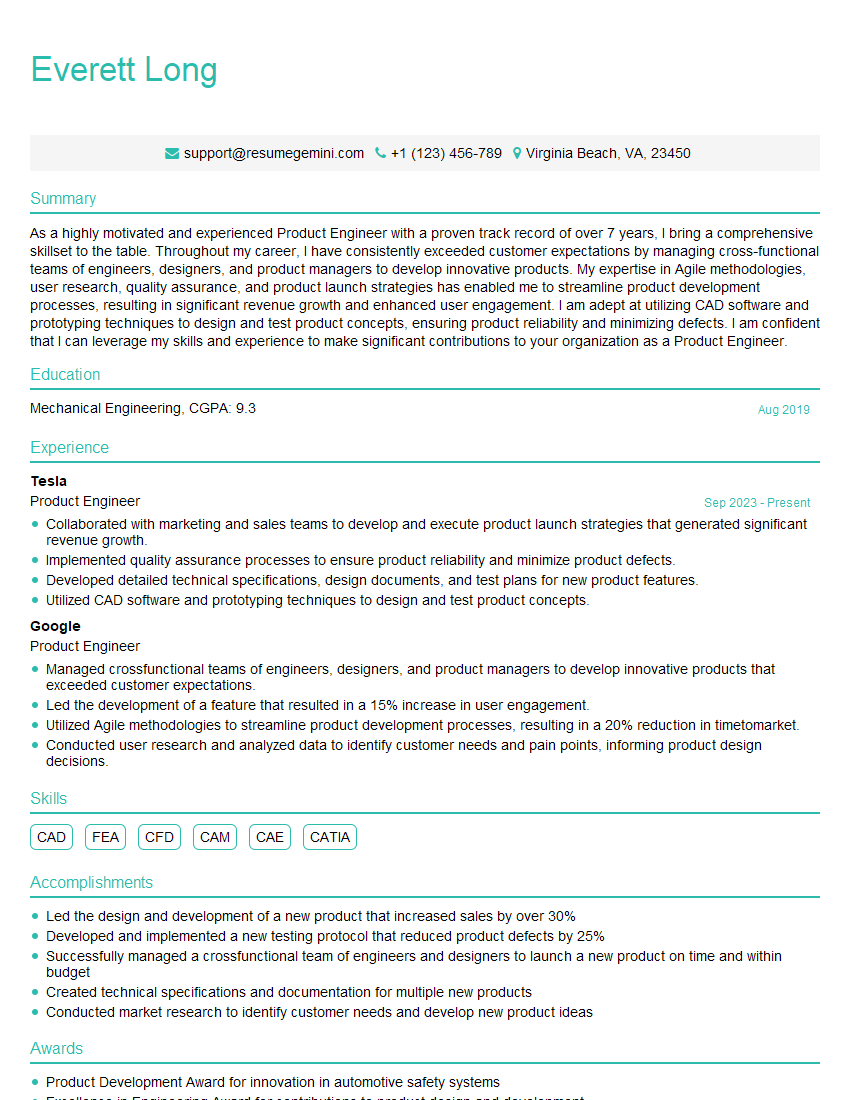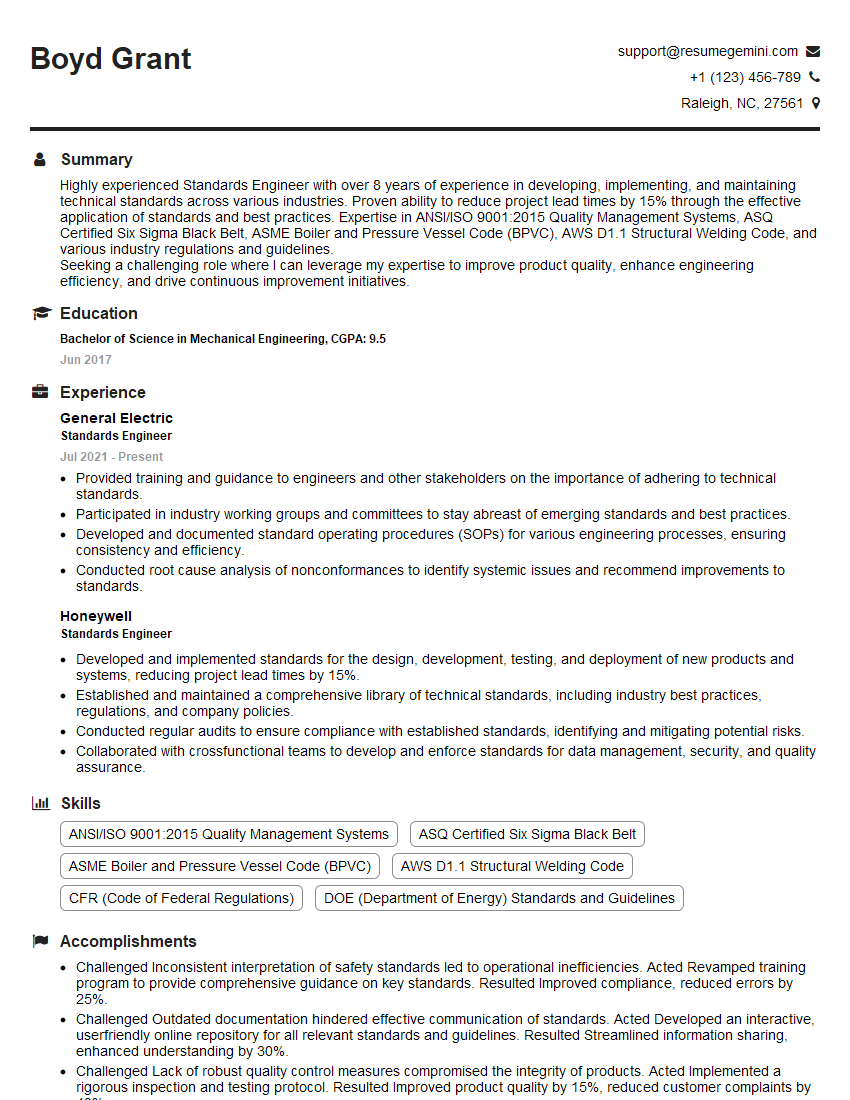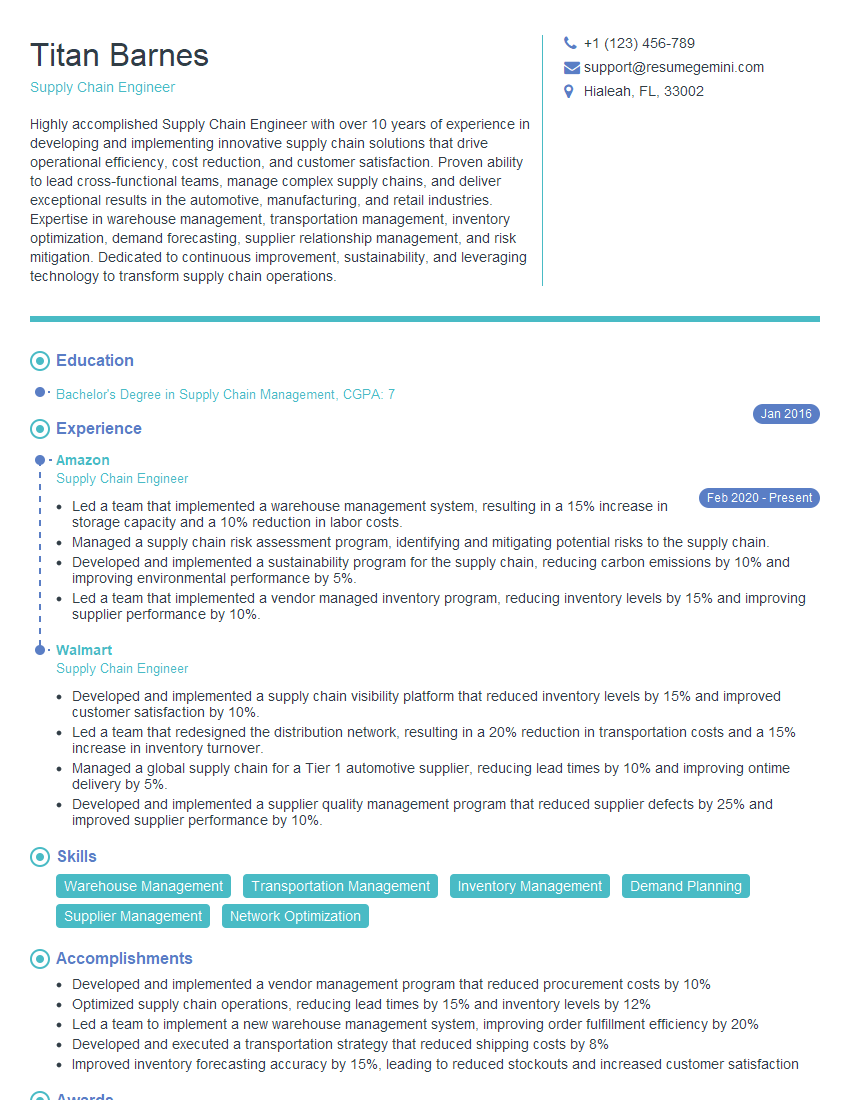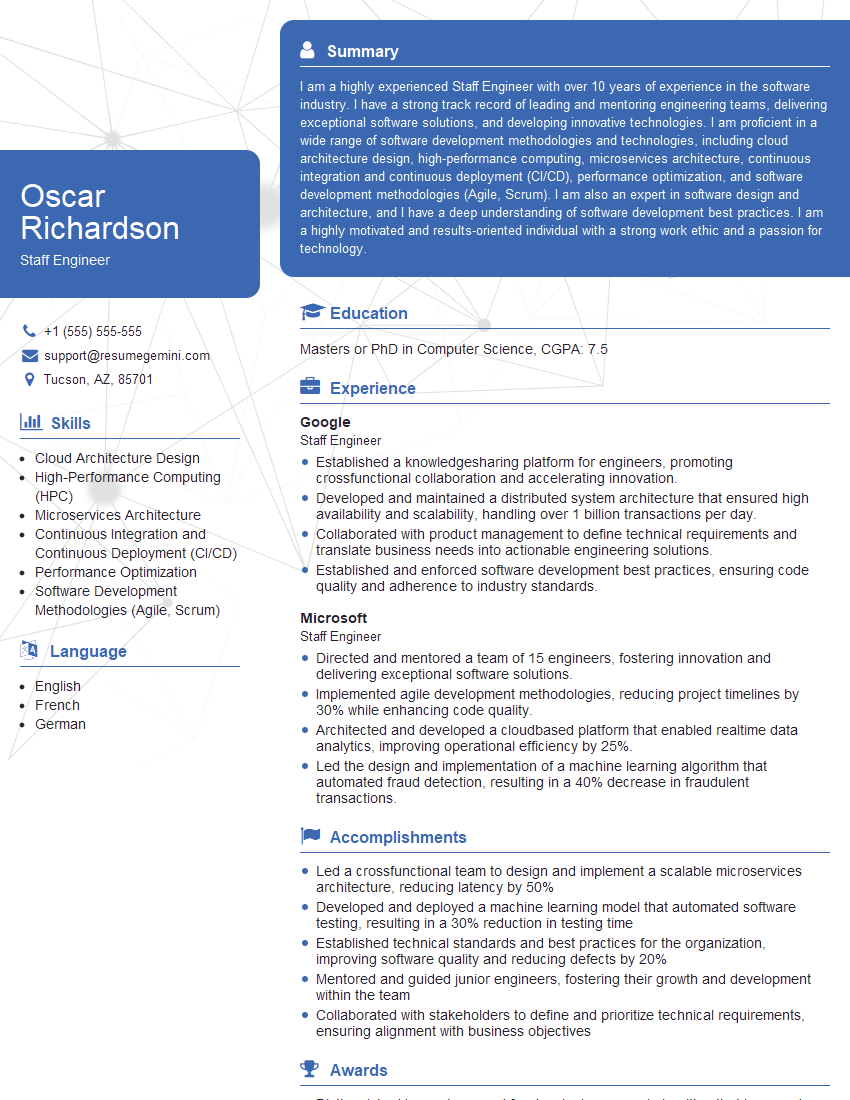Interviews are opportunities to demonstrate your expertise, and this guide is here to help you shine. Explore the essential Knowledge of Electronics Industry Standards interview questions that employers frequently ask, paired with strategies for crafting responses that set you apart from the competition.
Questions Asked in Knowledge of Electronics Industry Standards Interview
Q 1. Explain the significance of IEC 60068.
IEC 60068 is a cornerstone in electronics, defining a comprehensive series of environmental testing methods. Think of it as the ‘recipe book’ for ensuring your electronic product can withstand the rigors of real-world conditions. It doesn’t dictate specific pass/fail criteria; instead, it standardizes the *how* of testing, ensuring consistent and comparable results across different manufacturers and labs. This is vital for international trade and product reliability.
The standard covers a wide range of tests, categorized into different parts, each addressing a specific environmental stressor. For example:
- Part 2-1: deals with test methods for climatic and mechanical factors.
- Part 2-2: focuses on vibration testing.
- Part 2-30: covers accelerated tests for the evaluation of the performance of electronic equipment under operational conditions.
Imagine designing a ruggedized phone. IEC 60068 would guide you on the specific tests to perform, like drop tests (impact), temperature cycling, humidity exposure, and vibration simulations to prove its resilience. Without this standardization, comparing the robustness of different models from different manufacturers would be nearly impossible.
Q 2. Describe your experience with UL certification processes.
My experience with UL certifications spans over eight years, encompassing various roles from initial design review to final product submission. I’ve been directly involved in securing UL certifications for a range of products, including industrial controllers, medical devices, and consumer electronics. This involved extensive familiarity with UL standards, like UL 60950-1 for information technology equipment and UL 62368-1 for audio/video equipment.
The process typically begins with a thorough risk assessment to identify potential hazards. Then, we meticulously documented the design and manufacturing processes, ensuring compliance with relevant standards. This includes creating comprehensive test plans, conducting the necessary tests in a UL-recognized lab, and addressing any non-conformances identified by UL assessors. One particularly challenging project involved a medical device; the rigorous testing and documentation required were substantial, but ultimately resulted in a successful certification and market entry. This experience instilled in me a deep understanding of safety protocols and the importance of proactive risk mitigation.
Q 3. What is the difference between RoHS and REACH compliance?
Both RoHS and REACH are EU regulations aimed at protecting human health and the environment from hazardous substances, but they target different aspects and have distinct scopes.
- RoHS (Restriction of Hazardous Substances): Primarily focuses on restricting the use of certain hazardous materials in electrical and electronic equipment (EEE). Think of it as a list of substances you *cannot* use in your product above certain concentration limits. The most commonly known restricted substances are lead, mercury, cadmium, hexavalent chromium, PBBs, and PBDEs.
- REACH (Registration, Evaluation, Authorisation and Restriction of Chemicals): Has a much broader scope, encompassing the registration, evaluation, and authorization of all chemicals manufactured or imported into the EU in quantities exceeding one tonne per year. REACH places the responsibility for demonstrating the safe use of chemicals on manufacturers and importers. It also includes a list of substances of very high concern (SVHCs), which may be subject to authorization or restriction.
In essence, RoHS is a subset of REACH, specifically targeting EEE. A product compliant with RoHS would likely be compliant with the relevant REACH provisions, but not necessarily the other way around.
For example, a manufacturer must ensure their electronics comply with RoHS by using lead-free solder and other compliant materials. However, the same manufacturer must also comply with REACH for all the chemicals involved in their product’s manufacturing process.
Q 4. How do you ensure product safety according to relevant standards?
Ensuring product safety is paramount and involves a multi-faceted approach. It starts with a thorough understanding of relevant safety standards—both general ones like IEC 60068 and those specific to the product category, such as UL, CSA, or other regional standards. We then design with safety in mind, utilizing appropriate components, implementing robust protection mechanisms, and considering potential failure modes.
This is followed by rigorous testing throughout the product lifecycle, from component level to system level. We leverage various testing methods, including simulations, prototype testing, and environmental testing (as described in IEC 60068), to identify and mitigate potential hazards. Documentation is also critical; we maintain detailed records of our designs, tests, and any changes made during the development process. This ensures traceability and aids in troubleshooting should issues arise.
Continuous monitoring and improvement are key; post-market surveillance, customer feedback, and industry best practices help refine our safety procedures and identify potential areas for enhancement. Essentially, it’s a continuous cycle of design, test, verify, and improve, all underpinned by a strong commitment to safety.
Q 5. What are the key aspects of EMC compliance testing?
EMC (Electromagnetic Compatibility) compliance testing verifies that a product doesn’t emit excessive electromagnetic interference (EMI) that could disrupt other devices and that it’s immune to EMI from its environment. It’s crucial for preventing malfunctions and ensuring reliable operation of electronic devices.
Key aspects of EMC testing include:
- EMI testing: Measures the radiated and conducted emissions from the device. Radiated emissions are measured using an antenna in an anechoic chamber, simulating open-air conditions, while conducted emissions are measured using a line impedance stabilization network (LISN), assessing the interference conducted through power lines.
- EMS (Electromagnetic Susceptibility) testing: Evaluates the device’s resistance to various types of electromagnetic interference, such as radiated fields and conducted disturbances. This includes testing with various waveforms, frequencies, and amplitudes to simulate real-world conditions.
Think of a radio picking up static – that’s EMI. EMC testing ensures our products don’t cause such interference or succumb to it, maintaining a harmonious electromagnetic environment. Non-compliance can lead to product recalls, market restrictions, and regulatory fines, highlighting the importance of robust EMC testing and design practices.
Q 6. Explain your understanding of ESD protection and control.
ESD (Electrostatic Discharge) is the sudden flow of electricity between two objects with different electrostatic charges. It can damage sensitive electronic components and even cause system failures. ESD protection and control involve minimizing the risk of such discharges.
Key aspects include:
- Proper grounding: Ensuring that equipment and personnel are properly grounded to prevent charge build-up.
- ESD-safe work surfaces and tools: Utilizing conductive work surfaces and tools to dissipate static charges.
- Protective clothing and accessories: Wearing anti-static clothing and using grounding straps.
- Packaging and handling procedures: Employing anti-static packaging materials and handling procedures to prevent charge generation and accumulation during shipping and handling.
- ESD protection circuits: Incorporating protective circuits, such as TVS diodes and ESD protection arrays, within the electronic design to protect sensitive components from ESD events.
Imagine a tiny lightning strike hitting a delicate microprocessor. ESD protection prevents this damage. Implementing effective ESD control measures throughout the design, manufacturing, and handling processes is crucial to protect sensitive electronic components and ensure the reliability and longevity of the devices.
Q 7. Describe your experience with environmental testing (e.g., temperature, humidity).
Environmental testing, such as temperature and humidity cycling, is crucial to ensure product robustness and longevity. My experience includes overseeing and analyzing countless environmental tests across various projects, using climate chambers and specialized test equipment. I’ve worked with standards like IEC 60068 to determine the necessary test parameters and evaluate the results.
These tests simulate real-world conditions the product might encounter, like extreme temperatures, rapid temperature changes, and high humidity. The aim is to identify any weaknesses or failures before the product reaches the end-user. For example, we might subject a device to a temperature cycling test, ranging from -40°C to +85°C, to check for solder joint integrity or component degradation. We’ve also conducted humidity tests to evaluate corrosion resistance and material stability. The data collected is then analyzed to determine the product’s tolerance to these environmental stresses and to inform design improvements.
A particularly memorable project involved testing a solar panel designed for harsh desert conditions. The rigorous temperature cycling and humidity tests revealed a weakness in the sealant around the solar cells, leading to a design modification and ensuring the product’s long-term reliability in the target environment.
Q 8. How do you handle discrepancies between different international standards?
Handling discrepancies between international standards requires a systematic approach. Often, a product needs to meet multiple standards simultaneously (e.g., a device sold in both the EU and US must meet both CE and FCC regulations). The key is to identify the most stringent requirements among the conflicting standards. This often involves careful analysis of each standard’s specific clauses, focusing on aspects like safety limits, emission levels, and testing procedures.
For example, if one standard specifies a higher safety margin for a particular voltage level than another, we adopt the stricter one to ensure comprehensive safety. If there are conflicting testing methods, we may need to conduct tests according to both, choosing the method that provides the most thorough evaluation. Documentation is paramount; we meticulously record the standards considered, the chosen approach, and the rationale behind it, creating an audit trail to ensure compliance and facilitate troubleshooting.
In some cases, seeking clarification from standardization bodies might be necessary, especially when ambiguity exists between regulations. It’s also beneficial to proactively involve legal and regulatory compliance teams to ensure we remain legally compliant across all target markets.
Q 9. What is your experience with safety agency approvals (e.g., FCC, CE)?
I have extensive experience with safety agency approvals, notably FCC (Federal Communications Commission) and CE (Conformité Européenne) marking. My experience spans the entire process, from initial design considerations to final certification. This includes:
- Pre-compliance testing: Conducting thorough testing to identify potential compliance issues early in the design phase, saving time and costs later.
- Documentation preparation: Preparing meticulous technical documentation, such as test reports, schematics, and user manuals, required for submission to the agencies.
- Agency interaction: Effectively communicating with certification bodies, addressing their queries, and handling any necessary revisions to the design or documentation.
- Post-certification maintenance: Ensuring ongoing compliance through regular reviews and updates, particularly when there are changes in regulations or design modifications.
For instance, I successfully navigated the FCC’s Part 15 regulations for a low-power wireless device, resolving unexpected emission issues by implementing appropriate filtering and shielding techniques. Similarly, I guided the CE marking process for a medical device, ensuring compliance with all relevant electromagnetic compatibility (EMC) and safety directives (LVD).
Q 10. Explain your familiarity with IPC standards (e.g., IPC-A-610).
I’m very familiar with IPC (Institute for Printed Circuits) standards, particularly IPC-A-610, which defines the acceptability of printed board assemblies. IPC-A-610 serves as a benchmark for quality and reliability in electronic manufacturing. My understanding encompasses its various acceptance criteria, covering aspects like soldering, component placement, and visual inspection.
I use IPC-A-610 daily in several ways: during design reviews to ensure manufacturability; in the inspection of assembled boards to identify defects; and in training technicians on proper assembly techniques. I’ve used the standard’s classifications (Class 1, 2, and 3) to define the acceptable quality levels based on the application’s requirements – a high-reliability aerospace application demands a Class 3 standard, while a less critical consumer product might tolerate a Class 2.
Understanding IPC-A-610 not only ensures product quality but also facilitates effective communication with manufacturers and suppliers. A common language for quality expectations minimizes misunderstandings and disputes.
Q 11. Describe a time you had to troubleshoot a non-compliance issue.
During the production of a high-frequency communication device, we encountered a non-compliance issue with its radiated emissions, exceeding the FCC limits. Our initial testing identified a resonance issue within the PCB layout.
Our troubleshooting followed a systematic approach:
- Detailed analysis: We carefully reviewed the PCB design, considering signal paths, component placement, and ground planes.
- Targeted measurements: We used spectrum analyzers to pinpoint the frequency of the problematic emissions and their source.
- Countermeasures: We implemented several solutions, including adding ground planes, incorporating ferrite beads, and optimizing trace routing.
- Re-testing and verification: After each implemented countermeasure, we conducted rigorous testing to verify its effectiveness.
Ultimately, a combination of improved grounding and the addition of strategically placed ferrite beads resolved the emission problem, bringing the device into full compliance with FCC regulations. This experience highlighted the importance of meticulous design, thorough testing, and a structured approach to troubleshooting.
Q 12. How familiar are you with MIL-STD standards?
My familiarity with MIL-STD (Military Standard) standards is extensive. While I haven’t directly worked on military projects for many years, my foundation in these standards provides a robust understanding of high-reliability design and manufacturing principles. I understand the rigor and stringent requirements demanded by MIL-STD standards, such as those relating to environmental testing (MIL-STD-810), electromagnetic compatibility (MIL-STD-461), and quality assurance (MIL-STD-45662).
The key principles of MIL-STD standards—robustness, reliability, and traceability—are readily transferable to other sectors, particularly aerospace and medical. Even if not explicitly mandated, applying the philosophy behind MIL-STD requirements, such as comprehensive documentation and rigorous testing, is beneficial for designing reliable and high-quality products in any field.
Q 13. How do you ensure traceability of components to relevant standards?
Ensuring component traceability to relevant standards involves a multi-layered approach: a robust bill of materials (BOM), detailed specifications, and a reliable supplier management system.
The BOM must include not only the component’s part number and manufacturer, but also its relevant specifications and compliance certifications. We ensure every component has a unique identifier, linked to its datasheet, certificate of compliance, and test reports proving conformance to relevant standards. Our supplier management system requires that suppliers provide this detailed documentation and undergo regular audits to verify compliance. We implement a rigorous quality control system, including incoming inspection, to verify that received components meet the specified standards. A clear and readily accessible database allows for easy traceability throughout the product’s lifecycle, facilitating audits and assisting in case of product recalls.
Q 14. Explain your understanding of the product lifecycle and its relation to standards.
The product lifecycle significantly impacts how standards are integrated. From conception to disposal, standards influence each stage:
- Design Phase: Standards guide the design process, defining requirements for safety, performance, and environmental impact. We incorporate relevant standards from the outset to minimize potential compliance issues later.
- Manufacturing Phase: Standards dictate manufacturing processes, ensuring quality control and consistency. IPC standards, for instance, guide the assembly process.
- Testing and Verification: Standards define test methodologies and acceptance criteria, ensuring the product meets its specifications and complies with regulatory requirements.
- Distribution and Use: Standards ensure safe product operation and disposal, addressing aspects such as labeling, warnings, and end-of-life considerations.
- End-of-Life: Standards dictate proper disposal and recycling procedures, minimizing environmental impact.
Ignoring standards at any stage can lead to product failure, regulatory non-compliance, and legal liabilities. A proactive approach, integrating standards throughout the lifecycle, ensures a robust and compliant product, mitigating risks and enhancing its overall value.
Q 15. How do you stay updated on the latest changes in electronics industry standards?
Staying current with electronics industry standards is crucial for success. My approach is multi-faceted and proactive. I subscribe to industry newsletters and publications like those from IEEE, IEC, and UL. I actively participate in industry conferences and webinars, engaging with experts and learning about emerging trends and regulatory changes firsthand. For example, I recently attended a seminar on the latest revisions to the EMC Directive, gaining valuable insights into updated testing procedures and compliance requirements. Furthermore, I maintain memberships in professional organizations like IPC, allowing access to their resources, updates, and networking opportunities with other professionals. Finally, I use online databases like those provided by government regulatory bodies to search for and track changes in specific standards relevant to my work.
Career Expert Tips:
- Ace those interviews! Prepare effectively by reviewing the Top 50 Most Common Interview Questions on ResumeGemini.
- Navigate your job search with confidence! Explore a wide range of Career Tips on ResumeGemini. Learn about common challenges and recommendations to overcome them.
- Craft the perfect resume! Master the Art of Resume Writing with ResumeGemini’s guide. Showcase your unique qualifications and achievements effectively.
- Don’t miss out on holiday savings! Build your dream resume with ResumeGemini’s ATS optimized templates.
Q 16. What is your experience with documentation related to standards compliance?
My experience with documentation related to standards compliance is extensive. I’ve been involved in creating and maintaining a wide range of compliance documentation, including test plans, test reports, declarations of conformity (DoCs), and technical files. I understand the importance of meticulous record-keeping and traceability. For instance, in a recent project involving the development of a medical device, I created a comprehensive technical file that included all design documentation, test results, risk assessments, and regulatory approvals. This ensured full transparency and demonstrable compliance with relevant medical device regulations like ISO 13485 and FDA requirements. I am proficient in using various documentation management systems, ensuring efficient version control and easy access to relevant documents.
Q 17. Describe your approach to managing compliance costs.
Managing compliance costs effectively requires a strategic approach. My strategy focuses on proactive planning and risk assessment. This involves identifying potential compliance issues early in the design phase. For example, if we identify a component that might struggle to meet EMC standards, we explore alternatives that are inherently more compliant and minimize potential rework or costly remediation later in the process. I also advocate for using standardized components and designs wherever possible, as this reduces the need for unique testing and documentation. By proactively identifying and addressing compliance risks, we minimize the need for costly revisions and delays. Regularly reviewing and updating our processes ensures we’re utilizing the most cost-effective methods while maintaining compliance.
Q 18. How do you balance cost, time, and compliance requirements in a project?
Balancing cost, time, and compliance is a constant challenge in electronics projects. My approach involves a well-defined project plan that explicitly integrates compliance requirements from the outset. This is not an afterthought; it’s woven into every phase. We establish clear compliance targets and allocate sufficient budget and time for testing and documentation. A crucial part of this is conducting a thorough risk assessment. This allows us to prioritize compliance activities, focusing on the most critical aspects. For example, if a particular test is expensive and time-consuming, but the risk of non-compliance is low, we might explore alternative testing methods or reduce the scope of testing. This helps optimize our resources, ensuring we meet deadlines without compromising on quality or compliance. Regular progress reviews ensure we remain on track and adjust accordingly.
Q 19. Explain your experience with risk assessment related to product safety and compliance.
Risk assessment is a cornerstone of my approach to product safety and compliance. I utilize a structured methodology, often based on frameworks like FMEA (Failure Mode and Effects Analysis) or FTA (Fault Tree Analysis), to identify potential hazards associated with the product design and manufacturing process. This involves considering various factors such as component failures, environmental stresses, and human error. Each identified hazard is assessed for its severity, probability of occurrence, and detectability. The results guide the development of mitigation strategies, which might include design modifications, safety mechanisms, or warning labels. For example, in a recent project involving a high-voltage power supply, our risk assessment revealed a potential for electric shock. We addressed this by implementing multiple layers of protection, including insulation, grounding, and interlocks.
Q 20. What tools and techniques do you use to ensure standards adherence?
To ensure standards adherence, I use a combination of tools and techniques. This includes specialized testing equipment for EMC, safety, and environmental testing, such as spectrum analyzers, oscilloscopes, and thermal chambers. We also utilize simulation software to predict the behavior of circuits and systems, helping identify potential compliance issues early in the design phase. Furthermore, we use documentation management systems to track and control all relevant documents, and project management software to monitor progress and ensure compliance deadlines are met. Regular audits and internal reviews are essential to verify the effectiveness of our processes and identify areas for improvement. Finally, we utilize specialized software for managing compliance certifications and maintaining a record of our compliance activities.
Q 21. How familiar are you with the different types of testing required for electronics compliance?
My familiarity with electronics compliance testing is comprehensive. I have experience with various types of testing, including:
- EMC (Electromagnetic Compatibility): This covers testing for emissions and immunity, ensuring the product doesn’t interfere with other devices and can withstand electromagnetic interference.
- Safety Testing: This assesses the product’s safety against electrical hazards, like shock, fire, and overheating, and often involves tests like dielectric strength, insulation resistance, and creepage distance measurements.
- Environmental Testing: This evaluates the product’s ability to withstand various environmental conditions, such as temperature extremes, humidity, vibration, and shock.
- Reliability Testing: This determines the product’s lifespan and robustness. This might include life testing, stress testing, and accelerated life testing.
I understand the specific standards and regulations applicable to each test type, like IEC 61000 for EMC, IEC 60950-1 for safety, and various standards from IEC 60068 for environmental testing. The specific tests performed are dictated by the target market and regulatory requirements, with thorough documentation crucial throughout the entire process.
Q 22. Describe your experience with creating and implementing compliance plans.
Creating and implementing compliance plans involves a systematic approach to ensure our products and processes adhere to relevant industry standards and regulations. This begins with a thorough understanding of the applicable standards – for instance, IEC 60601-1 for medical devices, RoHS for restricted substances, or FCC regulations for radio frequency emissions. My experience encompasses the entire lifecycle, from initial risk assessment to ongoing monitoring.
First, I conduct a comprehensive gap analysis to identify the areas where our current practices may fall short of the required standards. This involves reviewing existing documentation, conducting internal audits, and interviewing key personnel. Then, I develop a detailed compliance plan that outlines specific actions, timelines, and responsibilities for achieving compliance. This plan includes resource allocation, training programs for relevant staff, and a robust documentation system to track progress and ensure traceability. Finally, I implement the plan, monitor its effectiveness, and make necessary adjustments along the way. For example, in a recent project involving a new medical device, I developed a compliance plan that included rigorous testing protocols, comprehensive documentation, and a detailed traceability matrix to meet the stringent requirements of IEC 60601-1. This proactive approach ensured a smooth certification process and minimized potential delays.
Q 23. How do you identify potential compliance risks during the design phase?
Identifying potential compliance risks during the design phase is crucial for preventing costly rework and delays later in the product lifecycle. This is achieved through a proactive, multi-stage approach that incorporates design reviews and risk assessments.
- Early Design Input: I ensure compliance requirements are clearly defined and integrated into the design specifications from the outset. This includes considering all relevant standards, regulations, and customer requirements.
- Design Reviews: Regular design reviews are held throughout the development process. These reviews involve cross-functional teams, including engineers, quality assurance personnel, and compliance specialists, to systematically assess potential compliance risks. We use checklists and matrices to ensure all aspects are covered.
- Failure Mode and Effects Analysis (FMEA): This systematic approach helps us identify potential failure modes, their effects on compliance, and the severity of the risks. This allows us to prioritize mitigation efforts.
- Simulation and Testing: Where possible, we use simulations and early prototyping to verify compliance before committing to full-scale production. This minimizes the risk of unexpected failures during later testing phases.
For example, when designing a power supply, we’d anticipate potential EMI/EMC issues and incorporate shielding and filtering measures from the initial schematic design. This proactive approach significantly reduces the likelihood of compliance issues during testing.
Q 24. Explain your experience with working with external certification bodies.
Working with external certification bodies is a critical aspect of ensuring product compliance. My experience involves liaising with several accredited bodies, including UL, TÜV, and Intertek, across various product categories. This includes preparing the necessary documentation, managing the testing and audit processes, and addressing any identified non-conformances. Effective collaboration requires a thorough understanding of each body’s specific requirements and procedures.
Successful collaboration relies heavily on clear communication and proactive engagement. I ensure all required documentation is meticulously prepared and submitted well in advance of deadlines. This proactive approach facilitates a smoother audit process and reduces the potential for delays. During audits, I maintain open communication with the auditors, addressing their queries promptly and transparently. If non-conformances are identified, I actively participate in developing and implementing corrective and preventive actions to address the issues. Maintaining a professional and collaborative relationship with certification bodies is crucial to ensure timely and efficient certification of our products. For example, in a recent project, we anticipated a specific issue related to a safety requirement. By working closely with the certification body beforehand, we were able to adapt the design and provide evidence to demonstrate compliance and avert any major delays.
Q 25. Describe a situation where you had to explain complex technical compliance issues to a non-technical audience.
Explaining complex technical compliance issues to a non-technical audience requires clear and concise communication, avoiding technical jargon whenever possible. I often use analogies and visualizations to simplify complex concepts.
For example, I once needed to explain the significance of EMC (Electromagnetic Compatibility) regulations to a group of executives. Instead of diving into technical specifications, I used the analogy of radio interference. I explained how a device emitting excessive electromagnetic radiation could disrupt other devices, similar to a loud radio station overpowering a quieter one. This analogy helped them grasp the importance of EMC compliance and its potential impact on the company’s reputation and product marketability. I also used visual aids, such as diagrams and flowcharts, to further illustrate the concepts and make the information more accessible. Successful communication ensured their understanding and support for necessary compliance investments.
Q 26. How do you handle conflicts between different engineering teams regarding compliance requirements?
Conflicts between engineering teams regarding compliance requirements often arise due to differing priorities or interpretations of the standards. My approach to resolving these conflicts involves fostering open communication and collaboration.
First, I facilitate a meeting involving all relevant stakeholders from the different engineering teams. The goal is to clearly define the compliance requirements and ensure everyone understands their responsibilities. I then encourage open discussion to identify the root cause of the conflict, whether it’s a misinterpretation of the standards, conflicting design choices, or resource constraints. Once the root cause is identified, I guide the teams to develop collaborative solutions that balance technical feasibility, cost-effectiveness, and compliance requirements. This often involves prioritizing requirements based on risk assessment and exploring alternative design approaches. Compromise and clear documentation of agreed-upon solutions are key to prevent future conflicts. For instance, if one team prioritized cost reduction while another focused on safety compliance, we might use a weighted risk assessment matrix to objectively evaluate the trade-offs and make informed decisions.
Q 27. What is your experience with conducting internal audits for compliance?
Conducting internal audits for compliance is a proactive measure to identify potential issues before they escalate. My experience includes developing audit plans, conducting audits based on relevant standards, and documenting findings and corrective actions. The aim is to ensure our processes and products consistently meet the required compliance standards.
I start by developing a detailed audit plan that outlines the scope, objectives, and methodology of the audit. This plan incorporates checklists, questionnaires, and sampling techniques to ensure comprehensive coverage. During the audit, I carefully review documentation, observe processes, and interview personnel to verify compliance. Findings are documented objectively, including any non-conformances or areas for improvement. Following the audit, I prepare a comprehensive report that summarizes the findings and recommends corrective and preventive actions. I then work with the relevant teams to implement the recommended actions and verify their effectiveness. Regular internal audits provide valuable insights into our compliance posture, enabling continuous improvement and proactive risk management. For example, a recent internal audit revealed a gap in our documentation procedures. By implementing a revised procedure and providing training, we ensured better traceability and improved overall compliance.
Q 28. How would you approach identifying and mitigating compliance risks in a new product development project?
Identifying and mitigating compliance risks in a new product development project requires a proactive and integrated approach that starts from the earliest stages of the project. This involves incorporating compliance considerations into the project plan and incorporating continuous monitoring.
- Early Stage Risk Assessment: At the beginning of the project, a thorough risk assessment is performed to identify potential compliance hazards. This includes considering all applicable standards, regulations, and industry best practices.
- Compliance Plan Integration: A detailed compliance plan is developed and integrated into the overall project plan. This plan outlines the activities, timelines, and responsibilities associated with meeting the compliance requirements.
- Design for Compliance: Compliance considerations are incorporated into the design phase, ensuring the product is inherently compliant. This includes using compliant components, designing for testability, and designing-in safety features from the start.
- Testing and Verification: Rigorous testing is conducted throughout the development process to verify compliance with all relevant standards. This includes EMC testing, safety testing, and other specialized testing as needed.
- Continuous Monitoring: Compliance activities are not limited to the development phase. Ongoing monitoring is necessary throughout the product lifecycle to ensure continued compliance and to address any new regulations or requirements.
For instance, in the development of a new consumer electronics device, I would ensure that the selection of materials adheres to RoHS requirements, that the design incorporates appropriate safety features to meet relevant safety standards, and that thorough EMC testing is performed to verify compliance with radio interference regulations. This proactive and continuous monitoring ensures that compliance is integrated into every stage, minimizing risks and ensuring successful product launch.
Key Topics to Learn for Knowledge of Electronics Industry Standards Interview
- Safety Standards: Understanding and applying relevant safety standards like IEC 60950-1 (Safety of Information Technology Equipment) or UL standards. Consider practical applications in design reviews and risk assessments.
- Electromagnetic Compatibility (EMC): Grasping concepts like conducted and radiated emissions, immunity testing, and the importance of meeting regulatory requirements like FCC regulations or CE marking. Explore real-world examples of EMC design considerations and troubleshooting.
- Environmental Standards: Familiarize yourself with RoHS (Restriction of Hazardous Substances) and WEEE (Waste Electrical and Electronic Equipment) directives, and their impact on product design and lifecycle management. Understand practical applications in material selection and end-of-life planning.
- Reliability and Quality Standards: Learn about key methodologies like FMEA (Failure Mode and Effects Analysis) and statistical process control (SPC) to ensure product reliability and quality. Discuss practical applications in manufacturing processes and quality assurance.
- Component Standards: Understanding standards related to specific components (e.g., capacitors, resistors) and their impact on circuit design and performance. Explore how industry standards ensure component interchangeability and reliability.
- Testing and Certification Procedures: Gain insight into the process of product testing and certification, including the role of third-party testing laboratories and the importance of documentation. Focus on practical approaches to managing the certification process.
Next Steps
Mastering knowledge of electronics industry standards is crucial for career advancement in this field. A strong understanding of these standards demonstrates your commitment to safety, quality, and regulatory compliance, making you a highly valuable asset to any electronics company. To significantly boost your job prospects, create an ATS-friendly resume that effectively showcases your skills and experience. ResumeGemini is a trusted resource that can help you build a professional and impactful resume tailored to the electronics industry. Examples of resumes tailored to highlight Knowledge of Electronics Industry Standards are available to guide you.
Explore more articles
Users Rating of Our Blogs
Share Your Experience
We value your feedback! Please rate our content and share your thoughts (optional).
What Readers Say About Our Blog
Hello,
We found issues with your domain’s email setup that may be sending your messages to spam or blocking them completely. InboxShield Mini shows you how to fix it in minutes — no tech skills required.
Scan your domain now for details: https://inboxshield-mini.com/
— Adam @ InboxShield Mini
Reply STOP to unsubscribe
Hi, are you owner of interviewgemini.com? What if I told you I could help you find extra time in your schedule, reconnect with leads you didn’t even realize you missed, and bring in more “I want to work with you” conversations, without increasing your ad spend or hiring a full-time employee?
All with a flexible, budget-friendly service that could easily pay for itself. Sounds good?
Would it be nice to jump on a quick 10-minute call so I can show you exactly how we make this work?
Best,
Hapei
Marketing Director
Hey, I know you’re the owner of interviewgemini.com. I’ll be quick.
Fundraising for your business is tough and time-consuming. We make it easier by guaranteeing two private investor meetings each month, for six months. No demos, no pitch events – just direct introductions to active investors matched to your startup.
If youR17;re raising, this could help you build real momentum. Want me to send more info?
Hi, I represent an SEO company that specialises in getting you AI citations and higher rankings on Google. I’d like to offer you a 100% free SEO audit for your website. Would you be interested?
Hi, I represent an SEO company that specialises in getting you AI citations and higher rankings on Google. I’d like to offer you a 100% free SEO audit for your website. Would you be interested?
good

